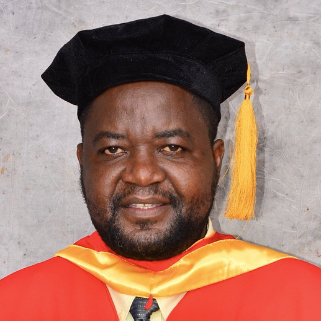Professor Nyambuya’s upcoming poster presentation on a plausible solution to the Hubble Tension via cosmologically varying fundamental natural constraints at the 32nd International Astronomical Union General Assembly 2024
Prof. Nyambuya is a true pioneer of Astrophysics in Zimbabwe, being the first Theoretical Astrophysics Doctorate on Zimbabwean soil, he is a well accomplished man. Currently based at the National University of Science and Technology (NUST) in Bulawayo, Zimbabwe, he has dedicated much of his time to mentoring students who have now made it their goals to have careers in astrophysics. Notably, Thobekile Ngwane, Ashley Nyamandi, and Praise Nesvinga!
This has been achieved this whilst also being a highly prolific researcher with over 70 published research papers, and having been appointed as Zimbabwe’s IAU National Outreach Coordinator. Prof Nyambuya will be attending the GA with one of his students Mr. Munashe Manyevere.
The poster that Prof. Nyambuya will be presenting is titled ‘A plausible solution to the Hubble Tension via cosmologically varying fundamental natural constraints’.
The Hubble tension is well known now by most astronomers, but here’s a recap: The universe is expanding at an ever increasing rate. How fast it does so is described by the so-called Hubble constant. But there is a dispute about how big this constant actually is, different measurement methods provide contradictory values, hence the ‘tension’.
Many scientists are puzzled by the tension and wonder if it leads to an unknown realm of physics, or if there may be some systematic issues leading to this perceived tension. Prof Nyambuya proposes what he describes as a plausible solution to this, read the abstract below to find out more!
Title – A Plausible Solution to the Hubble Tension via Cosmologically Varying Fundamental Natural Constants
Abstract – A number of scientists have wondered if the Hubble tension heralds some hitherto yet unknown physics or there might be some serious error in our methods and analysis? For a plausible solution, we suggest a cosmologically varying Planck constant — i.e., a Planck constant that varies in proportion to the cosmic expansion scale factor. This cosmologically varying Planck constant introduces a new correction term to the distance modulus. When the new corrected distance modulus term is applied to the Union2.1 dataset of 580 type Ia supernovae which typically yield: H0 ∼ 70-to-76 km/s/Mpc, we obtain a 99.49% (i.e., R2-value) fit between the proposed theory and the Union2.1 dataset of 580 SNe Ia and this impressive fit-to-data yields: H0 = 68.70 ± 0.30 km/s/Mpc. We consider our result to be in good agreement with that obtained by the Planck collaboration, thus, the tension in the two values may have found a solution worthy to be taken seriously. If acceptable, this solution somewhat forces physicists to the drawing board to re-consider and take much more seriously the idea of variable Fundamental Natural Constants (FNCs) as this phenomenon may introduce `dark’ effects which may be interpreted as darkenergy or darkmatter.



